Summary
Exploration on the Vietnamese continental shelf has been underway for more than 40 years, leading to the discovery of a number of oil and gas fields, including those with major and unique reserves.
In order to gain a detailed insight into the geology of sedimentary cover and identify productive zones as well as explore new prospective targets, Petrovietnam has initially applied a new method in seismic acquisition and processing - BroadSeis. BroadSeis was acquired with both 2D and 3D surveys over some blocks offshore southern Vietnam. This resulting seismic image has a much wider bandwidth at both ends of the spectrum than an image produced with conventional data.
This paper introduces some innovative enhancements to the traditional technique by the BroadSeis data acquisition and processing using CGG’s BroadSeis technology for the first dataset that was recorded over a part of Block 12/11 as well as the experiment 2D BroadSeis belonging to PVN-12 survey.
Key words: BroadSeis, broadband, deghost, variable depth streamer, PVN-12.
1. Introduction
Over the last 5 years, broadband seismic data has evolved as a result of seismic contractors having developed techniquesinacquisitionandprocessing to specifically address the sea surface ghost effects [1]. BroadSeis is a solution for broadband marine seismic to remove the receiver ghost and characterised by sharp, clean wavelets in the bandwidth of subsurface images, allowing for more detailed interpretation.
The first dataset acquired with the above technique and processed with the new de-ghosting scheme was recorded offshore NW Australia (Figure 2) [2]. Up to now, a lot of datasets across the world have been acquired and processed and these benefits have become increasingly apparent. Enhancements in data quality are observed in all ranges of geological settings.
In Vietnam, the first dataset acquired with the above technique was recorded in 2013 and processed with the new de-ghostingscheme over a part of Block 12/11 (Figure 1) to gain a detailed insight into the geology of sedimentary cover and identify productive zones. Based on the geological models of productive zones being constructed, the hydrocarbon reserves within the sedimentary section and the basement structures were estimated and further exploration conducted for new prospective targets [3, 4]. This 3D BroadSeis section improved in penetration and reflector continuity: sharper wavelets for better resolution of important features in both shallow and deep sections (Figures 6 and 7).
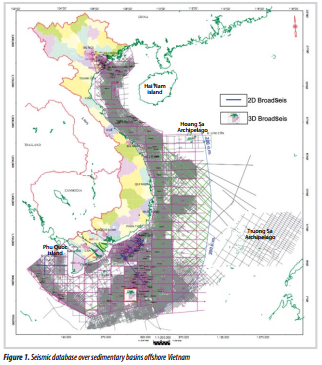
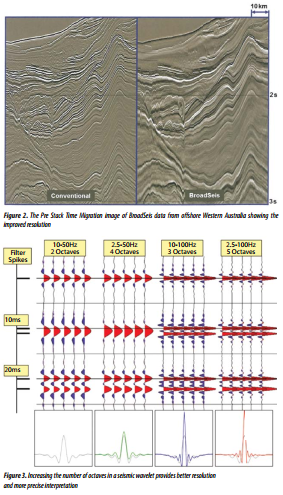
In 2015, 2D BroadSeis was shot within the PVN-12 survey (Figure 1) as an experiment. The results showed improvements over conventional data with high-quality images, providing better seismic resolution, stratigraphic detail and low-frequency content for deep images (Figures 8 and 9) [5, 6].
2. Overview of BroadSeis method
BroadSeis was introduced in 2010 by Soubaras [2, 7]. Being a marine broadband solution, BroadSeis incorporates variable receiver depths along a streamer. Starting from the nearest channel, the receiver depth increases with offset, introducing diversity in the receiver ghosts. At the same time, it is no more complex to acquire such variable-depth streamer data than to acquire conventional data since the same conventional solid streamers are towed at pre- defined variable depths, in a shape automatically regulated by the depth controllers. Finally, the seismic images obtained are consistently better than conventional data including vertical and lateral resolution as well as stratigraphic definition (Figures 2, 7 - 9).
BroadSeis variable-depth streamer acquisition is a CGGVeritas solution which uses a proprietary cable shape and a novel de-ghosting technique to remove the receiver ghost and extends the usable primary bandwidth up to 6 octaves (Figure 3) [2]. The principle of the de-ghosting technique is to produce a conventional migration as well as a mirror migration. This solution benefits from towing streamers at depths of up to 50 metres, which, combined with the use of solid streamers, ensures the raw data has an exceptionally good signal-to- noise ratio, especially at low frequencies. It provides robust removal of the receiver ghost across the full bandwidth of the recorded primary energy using hydrophone sensors alone, yielding broad bandwidth wavelets without side-lobes for enhanced seismic interpretation and improved inversion results [1, 2]. Broader bandwidths imply sharper wavelets with minimal side lobes. The ability to record a full range of frequencies, low as well as high (Figure 4), is key to increasing the resolution of both the shallow and deeper parts of the seismic section [2, 7 - 10].
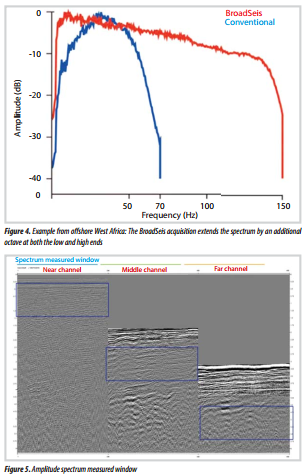
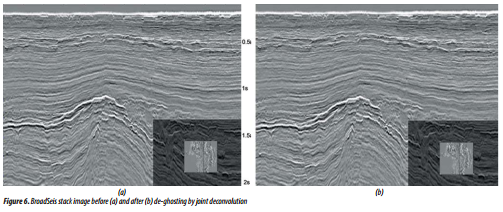

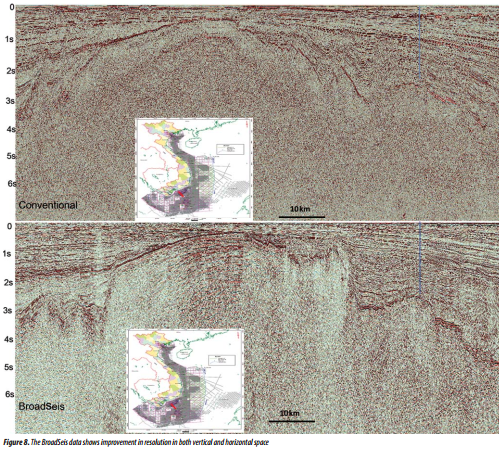

3. BroadSeis data examples in offshore southern Vietnam
3D BroadSeis: Vietsovpetro conducted the 3D BroadSeis over a part of Block 12/11 in Nam Con Son basin (Figure 1) where Geco-Prakla shot a conventional survey in 1996, and Petroleum Geo - Services (PGS) carried out two conventional surveys in 2001 and 2007.
This 3D BroadSeis was acquired by CGG from July to August 2013 by using CGG’s BroadSeis technology with solid streamers, towing cables and processed with the new de-ghosting method. In conventional acquisition, the data bandwidth is limited to a large extent by the presence of receiver ghost notch attenuating signal at both low and high frequencies. This attenuation is observed as notches in the amplitude spectrum (Figure 5). BroadSeis overcomes this by using variable-depth streamers, thus generating notches at different frequencies (i.e. ghost notch diversity). For processing this dataset, a de-ghosting algorithm that takes advantage of the notch diversity is used to remove the receiver ghosts and these result in a broadband output (Figure 6). Then a conventional migration as well as a mirror migration was produced before performing a joint deconvolution of these two images. A mirror migration is referred to as one which migrates from a duplicate set of receivers that are mirrored above the surface. As a part of the cable is towed at significantly deeper depths, it also records low frequencies better. The wavelet produced yields both a high signal-to-noise ratio and maximum bandwidth, which provides the BroadSeis section improved in penetration and reflector continuity with the clearest images of the subsurface for any target in the depth range from 1s to 5s (Figure 7).
2D BroadSeis: Petrovietnam carried out 2D BroadSeis (Figure 1). This 2D BroadSeis belonged to PVN-12 survey as experiment was acquired by the Binh Minh-02 vessel and processed by Fairfield Vietnam (FFVN) in 2015 [5]. It consists of about 1,215 full fold CMP km of 2D seismic data located in Cuu Long, Nam Con Son and Malay - Tho Chu basins (Figure 1). For all of these basins, there is a large legacy dataset including 2D and 3D surveys.
The main objective of this 2D BroadSeis experiment is to show improvements over conventional data by applying a correct de-ghosting method to the new technique of BroadSeis acquisition. This is a new technique which is designed to attenuate the source ghost and receiver ghosts on the data. The data was acquired with a variable depth streamer and one sequence with a flat streamer. So, two methods were applied - variable depth streamer de-ghost and flat cable de-ghost to enhance resolution in both vertical and horizontal space as well as to enhance fault imaging and deeper primary reflectivity (Figures 8 and 9). Shallow water demultiple (SWD) and 2D Surface Related Multiple Elimination (SRME) were applied. SRME is an effective tool for suppression of long period multiple and surface-related multiples in case conventional methods such as deconvolution or Radon demultiple may not work as effectively. When the water depth is less than 200 metres, SRME becomes less effective, SWD has been proved to work well in these situations [8, 9]. This methodology was applied to produce data with higher resolution, thus considerably improving the imaging of the unconformity compared to the legacy data: the BroadSeis data display seismic events with both stronger and more continuous reflectors as it is seen especially at the deeper part of the seismic section (Figures 8 and 9).
These above 2D and 3D BroadSeis data help seismic interpretation more intuited and detailed as they are superior to conventional data in providing clear differentiation between sedimentary packages and increasing confidence in correlating across faults and other major structural [3, 6].
4. Conclusion
BroadSeis acquisition and processing is the key technique for supplying wide bandwidth seismic data and allowing for more detailed interpretation.
2D and 3D BroadSeis data examples from some blocks in the southern part offshore Vietnam show that these data can deliver a wide frequency spectrum, enhancements in data quality are observed in all ranges of geological settings. And these benefits have become increasingly apparent.
In the coming year, in order to gain a detailed insight into the geology of sedimentary cover and identify productive zones as well as explore new prospective targets, more 2D and 3D BroadSeis data need to be acquired over the whole Vietnamese sedimentary basins, in particular the following priority areas: (1) Central trough of Song Hong, Cuu Long and Nam Con Son basins, (2) Phu Khanh, Tu Chinh - Vung May and Hoang Sa basins.
References
1. L.Amundsen, M.Landrø. Broadband seismic technology and beyond. GEOExpro. 2013; 10(1).
2. R.Soubaras, R.Dowle, R.Sablon. BroadSeis: Enhancing interpretation and inversion with broadband marine seismic. CSEG Recorder. 2012; 37(7).
3. Vietnam Oil and Gas Group. 3D sesimic data processing in Block 12/11 report. 2013.
4. Vietnam Oil and Gas Group. Interpretation of 3266 m2 3D PrSTM and 600km2 3D PrSDM in Block 12/11 report. 2015.
5. Vietnam Oil and Gas Group. 2D broadband seismic data processing report. 2015.
6. Vietnam Oil and Gas Group. Seismic data PVN12 processing and interpretation report. 2015 - 2016.
7. R.Soubaras. Deghosting by joint deconvolution of a migration and mirror migration. SEG Technical Program Expanded Abstracts. January 2010: p. 3406 - 3410.
8. Dechun Lin, Ronan Sablon, Yan Gao, Damien Russier, Danny Hardouin, Bruno Gratacos, Robert Soubaras, Peter Whiting. Optimizing the processing flow for variable - depth streamer data. First Break. 2011; 29: p. 89 - 95.
9. R.Sablon, et al. Demultiple for depth variant cable data from deep water to shallow water. Submission to 81th SEG Annual International Meeting. 2011.
10.Ronan Sablon, Damien Russier, Oscar Zurita, Danny Hardouin, Bruno Gratacos, Robert Soubaras, Dechun Lin. Broadband marine data require new processing techniques. 74th European Association of Geoscientists and Engineers Conference and Exhibition. January 1, 2013.